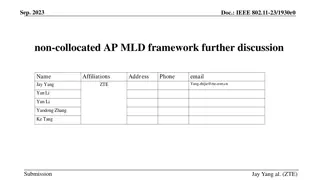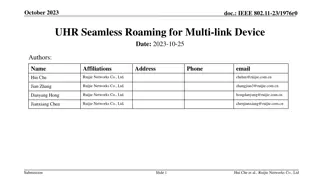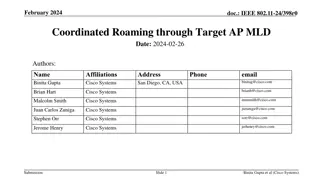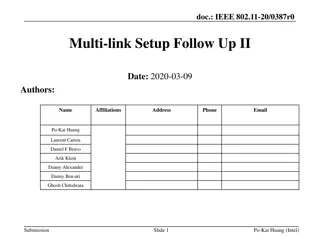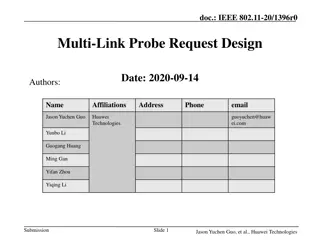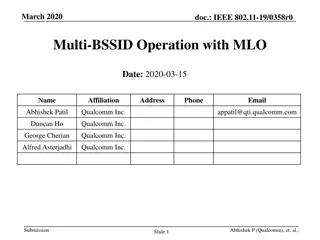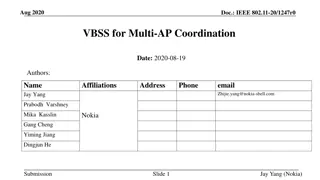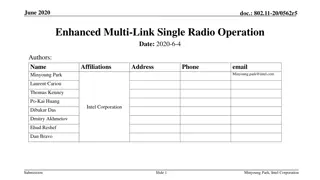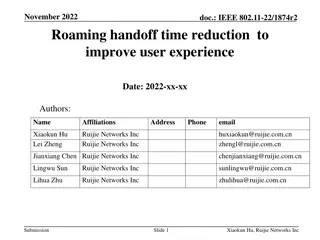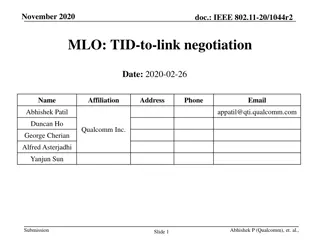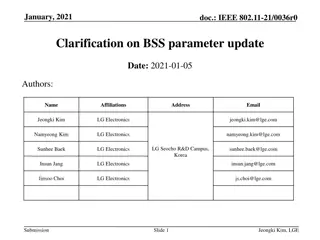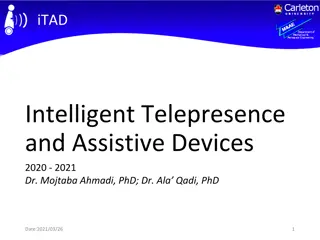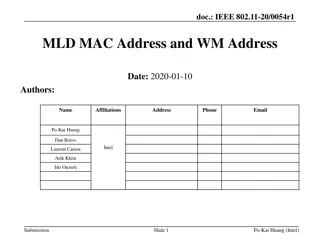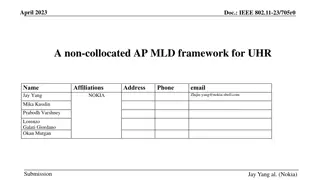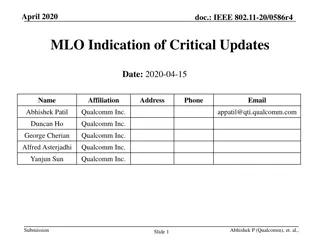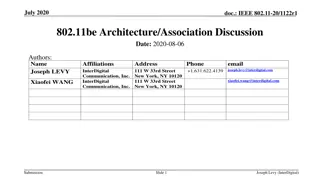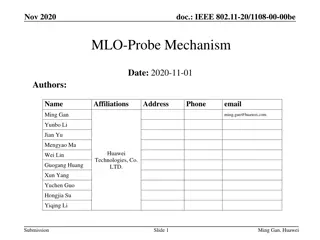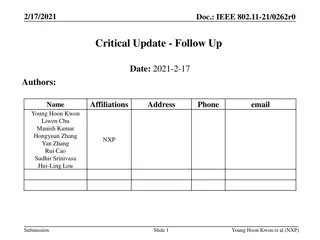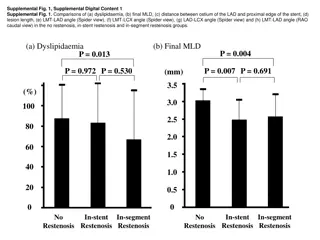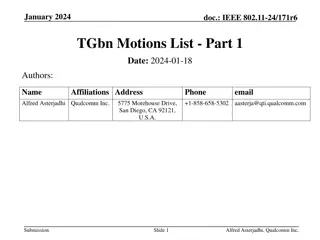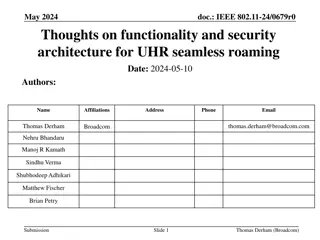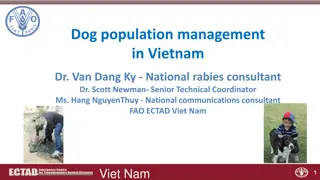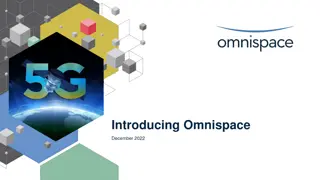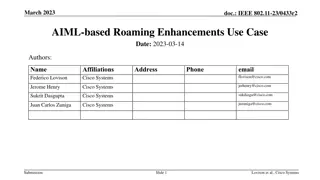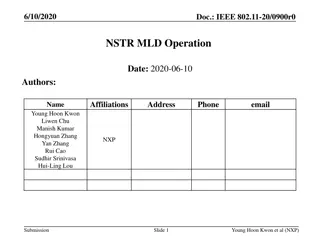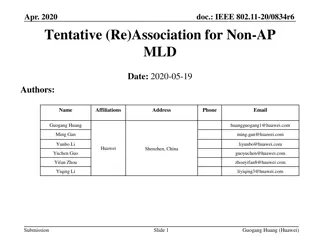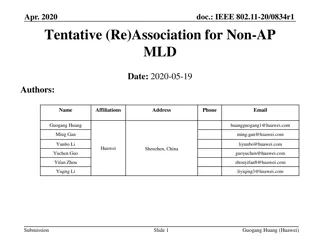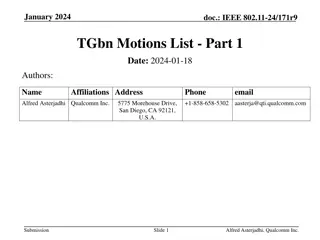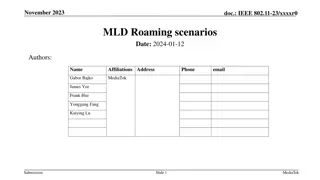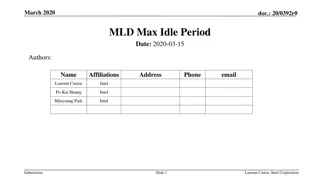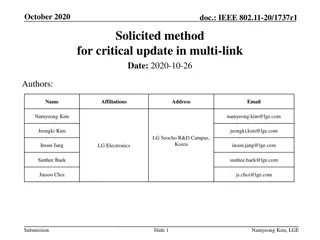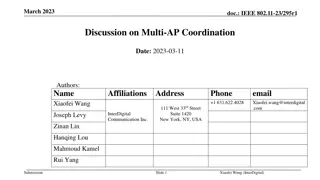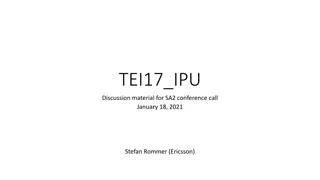Future of FTTR Products: Non-Collocated AP MLD Framework
In September 2023, IEEE 802.11-23/1930r0 discussed the use of non-collocated AP MLD framework in FTTR products for improved user experience. The framework aims to enhance Wi-Fi communication, seamless roaming, and Wi-Fi sensing integration. It simplifies AP MLD design, supports multiple links for in
6 views • 18 slides
Seamless Roaming for Multi-link Device in IEEE 802.11-23
Seamless Roaming scheme for non-collocated AP MLD in IEEE 802.11-23 aims to enhance roaming efficiency by utilizing multi-link operation. It addresses issues of data interruption and time wastage during traditional roaming processes. The mechanism involves sharing PTKs among non-AP STAs and storing
1 views • 14 slides
Coordinated Roaming Proposal for IEEE 802.11 Networks
This document presents a proposal for coordinated roaming through target AP MLD in IEEE 802.11 networks to address connectivity disruptions due to sudden RSSI drops or STA transition scenarios. The solution aims to ensure data continuity, preserve context, and minimize data loss during roaming hando
0 views • 11 slides
Progress on IEEE 802.11 Multi-link Setup
Significant developments have been made in the multi-link setup within the IEEE 802.11 framework. The focus is on allowing only one STA in the MLD framework, differentiation with STA-level associations, and the rationale behind restricting to one STA. Proposals for defining multi-link devices and re
0 views • 12 slides
Design Considerations for Multi-Link Probe Requests in IEEE 802.11-20
This document discusses the design considerations for multi-link probe requests in the IEEE 802.11-20 standard. It covers passive and active scanning methods, MLD-based versus link-based approaches, and probing for multiple BSSIDs. The focus is on enhancing efficiency and reducing frame bloating in
0 views • 16 slides
Multi-BSSID Operation with MLO Overview and Signaling Considerations
The document discusses the integration of Multiple BSSID set feature and Multi-Link Operation (MLO) in IEEE 802.11 networks. It delves into the setup of virtual Access Points (APs) on the same device with distinct attributes, the formation of common parameters across APs within an MLD, and the signa
1 views • 13 slides
IEEE 802.11-20/1247r0 VBSS for Multi-AP Coordination
IEEE 802.11-20/1247r0 discusses the concept of Virtual BSS (VBSS) for Multi-AP Coordination within the TGbe group. The VBSS infrastructure involves multiple AP nodes working on the same channel, sharing key information, and enabling seamless roaming and load balancing for improved throughput and low
1 views • 12 slides
Enhanced Multi-Link Single Radio Operation Proposal
The proposal discusses an enhanced mode of operation for single radio non-AP MLDs to enable multi-link operation, improving throughput and reducing latency. It addresses challenges in busy network environments, aiming to achieve low latency benefits similar to concurrent dual radio setups. The propo
0 views • 22 slides
Reducing Roaming Handoff Time for Improved User Experience in IEEE 802.11 Networks
The document discusses strategies to minimize roaming handoff time in IEEE 802.11 networks, focusing on enhancing user experience for latency-sensitive applications like video conferencing and online meetings. Emphasizing the importance of low latency in areas such as AR/VR and voice-over-Wi-Fi appl
0 views • 9 slides
IEEE 802.11-20/1044r2 TID-to-Link Negotiation Proposal
Proposal for a simple mechanism to negotiate TID-to-Link mapping between an Access Point MLD and a non-AP MLD to aid in traffic separation, latency-sensitive flow management, and overall channel access optimization. The negotiation process involves consideration of traffic profiles, load balancing,
1 views • 6 slides
Discussion on IEEE 802.11be MLD Architecture Alignment
IEEE 802.11 TGbe is exploring MLDs within the 802 architecture, focusing on aligning MLD operations with existing 802.11 features for enhanced compatibility. The MLD architecture aims to facilitate the flow of data between MAC SAPs and PHY SAPs, extending the current framework for APs and non-AP STA
1 views • 23 slides
IEEE 802.11-21/0036r0 BSS Parameter Update Clarification
This document delves into the IEEE 802.11-21/0036r0 standard, specifically focusing on the BSS parameter update procedure within TGbe D0.2. It details how an AP within an AP MLD transmits Change Sequence fields, Critical Update Flags, and other essential elements in Beacon and Probe Response frames.
1 views • 11 slides
IEEE 802.11-2020 Multi-Link Reference Model Discussion
This contribution discusses the reference model to support multi-link operation in IEEE 802.11be and proposes architecture reference models to support multi-link devices. It covers aspects such as baseline architecture reference models, logical entities in different layers, Multi-Link Device (MLD) f
1 views • 19 slides
Advancements in iTAD: Intelligent Telepresence and Assistive Devices 2020-2021
The iTAD project presents significant achievements in the development of assistive technologies, including Mobile Manipulator, Versatile Assistive Roaming System, and Remote Assessment of High-Risk Patients. Key accomplishments include patient interaction research, drivetrain and frame design, elect
0 views • 19 slides
IEEE 802.11-20/0054r1 MLD MAC Address and WM Address
In the document IEEE 802.11-20/0054r1, the focus is on Multi-Link Framework for MLD address identification and differentiation. It explains the usage of MLD MAC address and STA WM medium address in wireless setups. The document also addresses the need for identifying different MLDs using MAC address
0 views • 16 slides
Improving Latency Performance for Mobile Clients Using Non-Collocated AP MLD Framework
The UHR group aims to enhance latency performance for mobile clients by introducing a non-collocated AP MLD framework. This framework allows seamless transfer of client context between physical APs, improving roaming efficiency and supporting high numbers of links for non-AP MLDs. The proposed solut
3 views • 11 slides
IEEE 802.11-23/1980r1 Coordinated AP-assisted Medium Synchronization Recovery
This document from December 2023 discusses medium synchronization recovery leveraging multi-AP coordination for multi-link devices. It covers features such as Multi-link device (MLD), Multi-link operation (MLO), and Ultra High Reliability (UHR) capability defined in P802.11bn for improvements in rat
0 views • 8 slides
IEEE 802.11-20/0586r4 MLO Indication of Critical Updates
The document discusses the need for a mechanism in the MLO framework to enable non-AP MLDs to receive updates to operational parameters without monitoring all links. It proposes that each AP of an MLD should provide an indication of updates to another AP's operational parameters. It also outlines ho
0 views • 17 slides
IEEE 802.11be MLD Architecture Discussion
The document discusses the architecture of MLD (Multicast and Local Delivery) within the IEEE 802.11be framework. It highlights how MLD will align with existing 802.11 basic architecture, emphasizing the management of access to PHY and media for both AP and non-AP devices. The goal is to integrate M
0 views • 9 slides
IEEE 802.11be MLD Architecture Discussion
This presentation delves into architecture concepts for TGbe MLDs, focusing on AP and non-AP scenarios. It builds upon ideas from previous sessions, exploring topics such as RX/TX MSDU rate limiting, A-MSDU aggregation, packet integrity, and encryption. Implementation choices and legacy operation co
0 views • 15 slides
IEEE 802.11-20/1108-00-00be MLO Probe Mechanism in AP MLD
This document discusses the design and implementation of a mechanism for a non-AP STA to send a probe request frame to an AP within an AP MLD, allowing the STA to request a probe response containing information on all APs affiliated with the same MLD as the target AP. It proposes the use of new elem
1 views • 12 slides
IEEE 802.11-22/0349r1 Feb. 2022 Discussion of NSTR and EMLSR
Discussion on the introduction of eMLSR in IEEE 802.11-22/0349r1 compared to other modes like NSTR, with a proposal to make eMLSR support mandatory on AP MLD side due to its significant gains and importance in MLO. The presentation also highlights the performance comparison between NSTR and EMLSR, a
2 views • 12 slides
IEEE 802.11-21/0262r0 Critical Updates Discussion Summary
The document discusses critical updates related to IEEE 802.11-21/0262r0, focusing on changes in system information for APs within an AP MLD. It addresses scenarios where non-AP STAs receive Beacon frames with direct inclusion events, potential issues with updating critical information, and proposes
0 views • 9 slides
Comparisons of Dyslipidaemia and Lesion Characteristics in Restenosis Groups
This supplemental content presents comparisons of dyslipidaemia, final minimal luminal diameter (MLD), distance between ostium of the LAD and proximal edge of the stent, lesion length, and various angle measurements in different restenosis groups. The findings highlight significant differences in dy
0 views • 4 slides
IEEE 802.11-24/171r6 TGbn Motions List - January 2024
The January 2024 document highlights motions discussed and approved in IEEE 802.11 TGbn Task Group meeting. The motions include enhancements for Ultra High Reliability WLAN, additions to TGbn SFD for distributed-tone RU in TB PPDU transmission, and defining mechanisms for AP MLD roaming. The documen
0 views • 14 slides
UHR Seamless Roaming: Functionality and Security Architecture Proposal
Discussion on the technical requirements for UHR seamless roaming, focusing on the non-AP MLD state preservation and data exchange context between AP MLDs. Proposing a security architecture based on FT to achieve seamless roaming while cautioning against sharing PTK(SA) across multiple AP MLDs. Emph
0 views • 34 slides
Dog Population Management and Rabies Control in Vietnam
Vietnam faces challenges in managing its dog population and controlling rabies, with a significant number of unvaccinated roaming dogs posing risks to public health. The country has seen a rise in rabies cases, predominantly caused by dog bites, leading to a substantial annual death toll. Efforts ar
0 views • 23 slides
Omnispace: Redefining Global Mobile Connectivity with 5G NTN Technology
Omnispace, launching in December 2022, introduces the world's first global hybrid mobile network using 5G NTN technology to revolutionize mobile connectivity for consumer, enterprise, government, and IoT users. The innovative 5G hybrid architecture combines global NGSO coverage and mobile network ro
0 views • 10 slides
AI/ML-Based Roaming Enhancements for IEEE 802.11 Networks
This document presents AI/ML-based enhancements to reduce client latency in highly roaming environments within IEEE 802.11 networks. It proposes using AI/ML algorithms to predict client roaming behavior, prioritize scanning towards probable target access points, and improve overall roaming speed and
1 views • 19 slides
The Agony of a Caged Tiger - Poem Analysis
The poem "A Tiger in the Zoo" by Leslie Norris contrasts the confinement of a caged tiger with its natural habitat in the jungle, highlighting the agony, pain, and helplessness of the imprisoned animal. The poet vividly describes the majestic tiger's physical attributes and behaviors, emphasizing ho
1 views • 10 slides
Enhancing Network Performance with NSTR MLD and SR/eSR MLDs
This document discusses the performance characteristics of Multi-Radio MLD (NSTR MLD) and Single-Radio/Enhanced Single-Radio MLDs (SR/eSR MLDs) in various operation scenarios. It highlights the strengths and weaknesses of NSTR MLDs and proposes ways to improve their operation efficiency. Additionall
0 views • 16 slides
IEEE 802.11-20/0834r6: Make Before Break Scheme Implementation
This document discusses the Make Before Break scheme to minimize data delivery interruptions during roaming for a single-radio STA. It addresses the challenges of interrupted data delivery during tentative association with a new AP on a different channel and proposes solutions to implement this sche
0 views • 21 slides
IEEE 802.11-20/0834r1: Recap of Association and Fast BSS Transition
The document presents insights into tentative (re)association for non-AP MLDs, focusing on addressing data delivery interruptions during roaming and association with new access points. It covers necessary actions before data transfer, open system authentication, association operations, and fast BSS
0 views • 17 slides
IEEE 802.11 TGbn Motions Summary - January 2024
The January 2024 document from IEEE 802.11 TGbn Task Group chaired by Alfred Asterjadhi includes motions discussing enhancements for Ultra High Reliability WLAN. Motion 1 in the PHY domain relates to a distributed-tone RU for TB PPDU transmission. Similarly, Motion 2 in the MAC domain discusses mech
0 views • 25 slides
IEEE 802.11-23 MLD Roaming Scenarios
This contribution focuses on discussing MLD roaming scenarios to enable seamless roaming for non-AP MLD STAs, aiming to reduce packet loss and latency during roaming through methods like make before break. Various aspects of Intra V-MLD Roaming architecture are explored, including optimizing data pa
0 views • 17 slides
Proposal to Simplify MLD Max Idle Period for Non-AP MLDs
Proposal presented in March 2020.doc suggests defining the MLD Max Idle Period at the MLD level instead of the STA level for non-AP MLDs. The objective is to indicate to APs through keep-alive frames that the non-AP MLD is still active without needing to tear down multi-link setups. The proposal off
0 views • 4 slides
Solicited Method for Critical Update in Multi-Link Environments
This document discusses a method for obtaining critical update information for Access Points (APs) within the same Multi-Link Domain (MLD) in IEEE 802.11 standards. It introduces the concept of Change Sequence fields in Beacon and Probe Response frames to indicate changes in system information for o
0 views • 18 slides
Overview of 5G System Architecture and User Plane Functionality
This content showcases various aspects of 5G system architecture, including system handover, non-roaming architecture, service-based architecture, and user plane functionality. It delves into the control plane functions, user plane functions, and core network endpoints of the 5G network. The images
0 views • 49 slides
Discussion on Multi-AP Coordination Architecture in IEEE 802.11-23
In this document, Xiaofei Wang from InterDigital Communication Inc. discusses the architecture required for multi-AP operations, seamless roaming support, and general MLD operation support in the context of IEEE 802.11-23 standards. The focus is on coordinating various operations across multiple APs
0 views • 9 slides
Evolution of IP Pool Information Management in 5G Networks
Discussion material for SA2 conference call featuring Stefan Rommer (Ericsson) on defining the support for providing IP pool information from UDM to SMF, focusing on non-roaming and home-routed roaming scenarios in the same PLMN. It covers background on SMF's allocation of UE IP addresses, cases in
0 views • 4 slides
